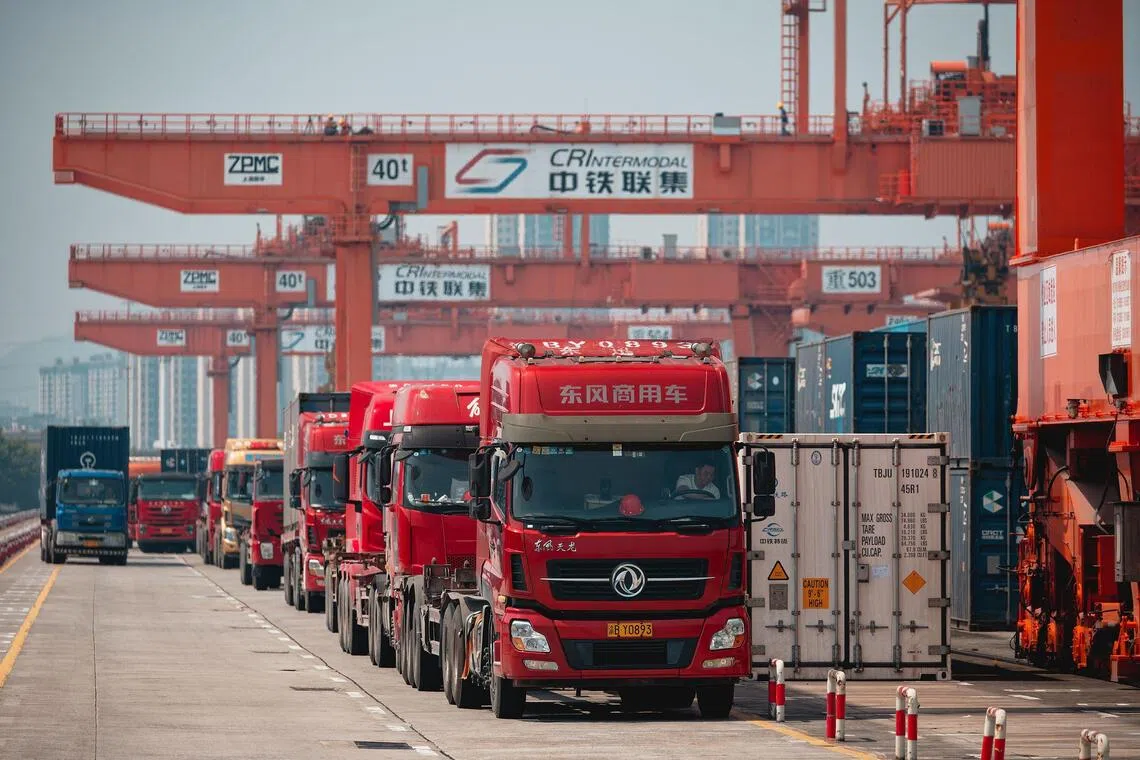S’pore investments in Chongqing more than doubled in a decade: Tan Kiat How
Sign up now: Get ST's newsletters delivered to your inbox

Container volumes under a rail-sea multimodal transportation route for goods, linking Chongqing to Singapore, have grown nearly tenfold since 2019.
PHOTO: EPA
Follow topic:
SINGAPORE – Investments from Singapore into Chongqing have more than doubled from US$5.7 billion (S$7.4 billion) in 2015 to US$12.7 billion in 2024, as the Republic’s businesses tapped opportunities in the western Chinese city.
Cooperation with Chongqing has strengthened since the China-Singapore (Chongqing) Demonstration Initiative on Strategic Connectivity (CCI) was launched, Senior Minister of State for Digital Development and Information Tan Kiat How said on Sept 29.
CCI is the third government-to-government project between Singapore and China, and was launched in November 2015.
Mr Tan said container volumes under a rail-sea multimodal transportation route for goods, linking Chongqing to Singapore, have grown nearly tenfold since 2019.
Chongqing has also overtaken Guangzhou to become China’s fourth-largest economic hub, after Shanghai, Beijing and Shenzhen.
In addition, the megacity has seen growth in local and foreign tourists. Singapore has also seen strong travel demand from visitors from Chongqing, with around 46,000 visiting from January to September.
“It is a significant consumer market, tourist destination and important economic hub in this part of China,” Mr Tan said in an interview with local media ahead of the opening ceremony of the 2025 Experience Singapore Week in Chongqing.
“There are many opportunities for us to continue growing our bilateral trade and economic linkages.”
Mr Tan cited Raffles Hospital Chongqing and Raffles City Chongqing as examples of the confidence Singapore companies have in the market.
He encouraged businesses that are considering expanding into western China to visit Chongqing, and use platforms like the Joint Innovation Development Fund, which supports collaboration between Singapore and Chongqing companies.
The Experience Singapore Week from Sept 29 to Oct 2 is co-organised by the Singapore Ministry of Trade and Industry and the Chongqing municipal government to commemorate the 10th anniversary of the CCI.
It features Singapore brands, hawker stalls and an interactive zone showcasing iconic attractions like Gardens by the Bay and Sentosa.
Mr Tan, Chongqing’s vice-mayor Xu Jian, and over 80 guests and officials from Singapore and Chongqing were present at the opening ceremony.
It follows the Chongqing Week held in Orchard Road in June, which showcased Chongqing’s cultural heritage through traditional handicrafts such as the Jiulongpo paper-cutting art and delicacies like Rongchang braised goose.
Mr Tan said the CCI will be extended into the green and digital economy spaces, beyond its current focus on financial services, aviation, transport and logistics, and information and communications technology.
“These are the new elements we are bringing into the CCI projects for the next front,” he said.
More details on the upcoming initiatives will be shared at a top-level annual bilateral platform, the 21st Joint Council for Bilateral Cooperation, which will be held in Chongqing later in 2025.
Singapore’s first intergovernmental project with China – the Suzhou Industrial Park – was launched in February 2004.
This was followed by the countries’ second joint initiative, the Tianjin Eco-City. It was mooted by Singapore’s then Senior Minister Goh Chok Tong and then Chinese Premier Wen Jiabao, against the backdrop of rapid urbanisation in China and the global attention on sustainable development.
The eco-city now houses more than 150,000 residents, up from 10,000 in 2012.

